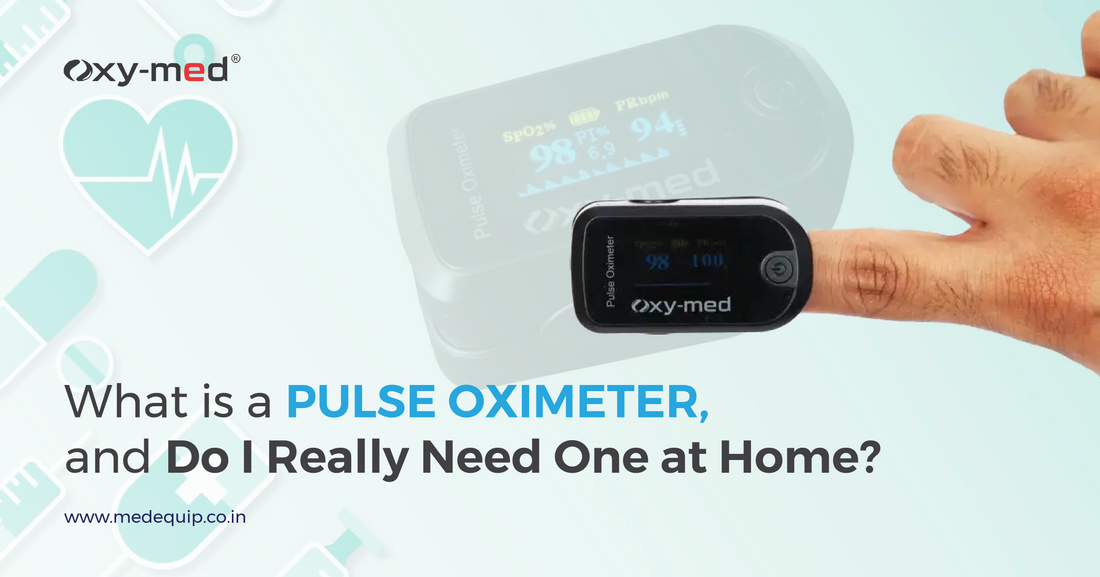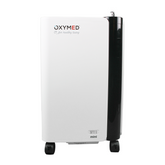What is a Pulse Oximeter and Do I Really Need One at Home
Every industry has benefited from technological advancements that have made people's lives easier, and home healthcare is one among them. Home healthcare solutions are successful in delivering speedier results for monitoring one's health without leaving the house and have given reliability to the less fortunate. A pulse oximeter is also one of those practical instruments.
During COVID-19, pulse oximeters served the purpose of assisting the patients in keeping track of their blood oxygen levels. It is useful because it can recognize and detect variations in blood oxygen saturation levels when a medical emergency calls for at-home monitoring
Let us know what the device pulse oximeter, its benefits, and why anyone needs it is.
What is a Pulse oximeter?
A pulse oximeter is a tiny electronic device that measures the blood's oxygen saturation level and pulse rate. The electronic device is attached to the right thumb or right middle finger with a clip. The oxygen saturation and heart rate are displayed immediately on the device's surface on the display screen.
A pulse oximeter is required, right?
Doctors recommend a pulse oximeter if the person's blood oxygen level needs to be monitored frequently.
Pulse Oximeters can be useful in the below conditions if the person is suffering from:
-
Sleep apnea - a potentially dangerous sleep disorder when breathing frequently pauses and resumes.
-
allergies that affect breathing caused by dust,
-
Lung infections and lung disorders,
-
Pneumonia, Suffocation, and choking
-
A history of difficulty in breathing even in normal weather conditions
If the patient has a history of shortness of breath and is prone to inhaling chemicals on a daily basis, the pulse oximeter device is advised. Additionally, it is encouraged when keeping an eye on exercise plans, cardiovascular, and other respiratory health concerns.
The features of Pulse Oximeter:
Easy-to-use: The device only has one button, making it simple to use. Simply clip the pulse oximeter on your finger, push the button, and look at the LCD to monitor the readings.
Portable: The portable pulse oximeter fits easily in a pocket or purse and can be used anywhere.
Break-resistant: The device is absolutely appropriate for daily usage and is break resistant.
Programmable Alarms: The device is set up with an alarm that alerts if the person's blood oxygen level is dropping
Cost-effective: Accurate readings on blood saturation levels can be obtained being home or in other "out of the hospital" circumstances.
Auto power off and low battery indicator: The device automatically turns off if it is not in use and indicates the user during the low battery.
Helps in the diagnosis of risks: The normal Blood oxygen saturation level should be between 96% to 99%, and the heart rate should be 50-90 bpm (beats per minute). If the blood oxygen levels are dropping, the device clearly indicates it with the numbers and helps prevent the risks.
Conclusion
Doctors recommend Pulse oximeters if you are in need; however, if you are the device can be used as it is the most preferred device with 0% side effects.
Related Products
-
Pulse OximeterThe Oxymed Pulse Oximeter is a compact, user-friendly device designed to accurately measure blood oxygen levels (SpO2) and pulse rate, providing critical insights into your respiratory health. Ideal for individuals with respiratory conditions, athletes, or anyone monitoring their health, this pulse oximeter allows for...
- ₹ 1,500.00
₹ 1,890.00- ₹ 1,500.00
- Unit price
- / per
-
Auto CPAP - Sleep EasyThe Oxymed Auto CPAP - Sleep Easy Machine is a user-focused breathing support device designed to promote consistent airflow during rest. Combining smart features with ease of use, it supports a more restful breathing experience. The device auto-adjusts airflow based on user patterns, making...
- ₹ 31,900.00
₹ 60,990.00- ₹ 31,900.00
- Unit price
- / per
-
Oxygen Concentrator Mini - 5 LPMThe Oxymed Oxygen Concentrator Mini - 5 LPM is a compact and easy-to-use oxygen delivery system designed for general wellness applications in home environments. With a flow capacity of up to 5 litres per minute, it provides adjustable oxygen enrichment for personal use. Its...
- ₹ 36,900.00
₹ 65,990.00- ₹ 36,900.00
- Unit price
- / per
-
Oxygen Concentrator Mini - 10 LtrThe Oxymed Oxygen Concentrator Mini - 10 Ltr is a powerful, efficient, and medical-grade oxygen delivery solution designed for individuals requiring high-flow oxygen therapy. Engineered with advanced technology, this device ensures a steady and uninterrupted supply of oxygen, making it ideal for home and...
- ₹ 52,000.00
₹ 118,990.00- ₹ 52,000.00
- Unit price
- / per
-
Portable Oxygen Concentrator P2The Oxymed Battery-Powered Portable Oxygen Concentrator P2 is a lightweight, travel-friendly device designed for individuals who need oxygen therapy on the go. With pulse dose technology, it provides efficient oxygen delivery while ensuring maximum mobility. Whether at home, traveling, or outdoors, this concentrator offers uninterrupted...
- ₹ 137,900.00
₹ 219,990.00- ₹ 137,900.00
- Unit price
- / per
-
Hepa NebulizerThe Oxymed HEPA Nebulizer is a high-performance respiratory device designed to provide effective treatment for respiratory conditions such as asthma, chronic obstructive pulmonary disease (COPD), and other pulmonary diseases. Featuring advanced HEPA filtration, this nebulizer ensures the delivery of clean, purified air during treatments,...
- ₹ 1,980.00
₹ 2,200.00- ₹ 1,980.00
- Unit price
- / per
-
Ultra NebulizerThe Oxymed Ultra Nebulizer is a cutting-edge device designed to provide fast, efficient, and comfortable nebulization therapy for individuals with respiratory conditions such as asthma, COPD, and bronchitis. Engineered with advanced technology, this nebulizer delivers medication in fine mist form, allowing for better absorption...
- ₹ 2,190.00
₹ 2,300.00- ₹ 2,190.00
- Unit price
- / per
-
Oxymed Suction MachineThe Oxymed Suction Machine is a reliable and high-performance device designed for efficient suctioning of fluids, secretions, and mucus from the airway. Perfect for medical facilities, home care, and emergency use, this suction machine is ideal for patients who need assistance with respiratory clearance,...
- ₹ 7,499.00
₹ 8,315.00- ₹ 7,499.00
- Unit price
- / per












